Background
The earliest 1900 Lugers produced with the United States American Eagle crest applied to the chamber are in the low 2100 commercial serial number range and were assembled with spare 4-¾” 30 Cal barrels from the Swiss contract as evidenced by the Swiss inspection cross applied to the barrel. They had 2nd issue cross hatched Thumb Safety levers and 1st issue narrow Grip Safeties. The take down lever was stamped with the last 2 digits on the right side. Some of these early American Eagle Lugers were sold in presentation cases. Featured is one of these early cased American Eagle Lugers.
The next commercial serial number block of old model American Eagle Lugers appears in the 5600 serial number range, which are also configured with 2nd issue Thumb Safety levers and 1st issue Grip Safeties. An example being an American Eagle, configured with an early Ideal holster rig, probably 1901 based on the low 4-digit serial number.
When the word rig is used the normal assumption is that the components or parts of that rig are contemporaneous to each other which is not necessarily true. Many Luger rigs consisting solely of a holster and pistol to a complete cased rig with several accessories are put together by collectors as the individual accessories are located. In the case of the subject Ideal rig, based on wear patterns on certain areas of the pistol, could only have come from being in long contact or use with the Ideal holster.

United States Army Model 1900 Test Eagle Lugers
The next major serial number block of American Eagle Lugers are the approximately 1,000 American Eagles sold to the U.S. Army commonly designated the U.S. Test Eagle Luger. The commonly accepted serial number range is 6100 to 7100. These AE Lugers have the same 2nd issue Thumb Safety and 1st issue Grip Safety. Shown below is a U.S. Test Eagle Luger rig with some unusual accessories. The U.S. Test Eagle Luger and the Rock Island Holster are in exceptional condition and were originally issued together as the holster has been with the pistol since it was issued in 1901.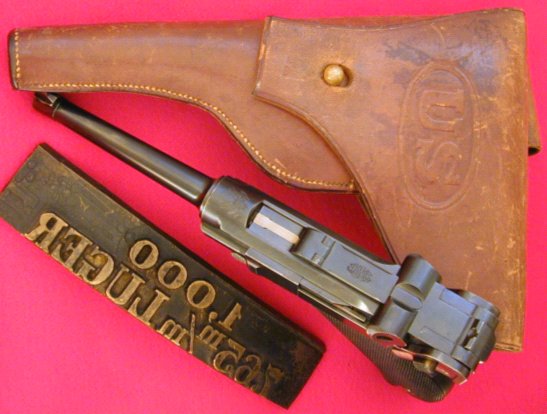
This has been determined by a close examination of wear patterns found on the pistol and holster that are unique to each other. There is a circular indent in the right side wooden grip that coincides, in location and diameter, with a protruding rivet on the inside surface of the holster body. The two align closely with the pistol fully holstered and the flap secured to the holster body. The characteristics of the inner circular indent, with the hatching pattern worn smooth and the slightly uneven worn area surrounding the indent suggest that the main depression wear was incurred by long term storage. The uneven outer circumference wear was by a constant minute shifting of the pistol in the holster, the latter a direct result of the holster and pistol being worn by a horse mounted U.S. Calvary soldier. The loose or protruding rivets are a result of stress encountered by the constant tension or jostling of the weight of the holster body and pistol against the belt loop, being applied while being worn by a rider on a horse, i.e. again the U.S. Cavalry.
Per current literature the United States Army excessed or sold off what was left of their inventory of U.S. Test Eagle Lugers and their specially made Rock Island holsters to Francis Bannerman and Company in 1911 who subsequently offered them to the public. In actuality this is not true for all of the U.S. Test Eagle Lugers as there was an earlier April 1903 less publicized agreement to exchange of 50 of the Army’s best condition U.S. Test Eagle Lugers in trade for the 50 9mm Cartridge Counter Lugers provided by DWM. “The Board proposes to turn in fifty of the 7.65 pistols now on hand in good condition…” On May 12th (1904) Hans Tauscher wrote the Commanding Officer at Springfield Armory regarding the 50 7.65 m/m pistols to be exchanged. “…I beg to request to kindly ship, in exchange of the 50 Luger pistols, cal 9mm, 50 Luger automatic Pistols 7.65 m/m of first class condition to the following address: Mr. A.H. Funke, 83 Chambers Street, New York City” As it turns out A.H. Funke was a commercial retailing firm and they simply sold off the exchanged 50 U.S. Test Eagles. It is possible therefore that in light of the exceptional condition of the subject U.S. Test Eagle Luger and holster that it was one of the 50 sold off by A.H. Funke.
Accessories
On November 14th, Lt. Colonel Phipps advised the Chief of Ordnance of the completion of issues as ordered.
“… 5 Luger pistols to each Troop of Calvary, and instruction as to…reports, etc, have been complied with…
3 descriptive books were sent with each 5 pistols issued.”
In an effort to minimize the problem of misfires, the adjutant General issued a circular, dated September 1902, which stated:
“…the attention of all officers to whom the Luger automatic pistols have been issued for trial and report is invited to instructions for cleaning the pistols given in paragraph 8, page 12 of Directions for the Use and Manipulation of the Parabellum Automatic Pistol, issued with the pistols.”
It has always been assumed that the manual used by the U.S. Army was the DWM, Berlin printed, circa 1902 red cover with gold lettering commercial instruction manual. The word assumed is used because although many of these instruction manuals survive it is impossible to associate any existing manual with the U.S. Army as apparently the manuals issued were not stamped or identified by the U.S. Army.
Apparently this is not page 12 of the circa 1902 red cover commercial manual described as “descriptive book” by the U.S. Army referenced above. The referenced section cited above appears as the last paragraph of a section titled: The Caliber of the “Parabellum” Automatic Pistol starting on page 9 of the 1902 DWM red cover commercial instruction manual.
In actuality paragraph 8, page 12 as referenced by the U.S. Army is located in the first DWM English language instruction manual with a gray cover with black lettering titled: PARABELLUM Automatic Pistol - Borchardt-Luger’s System. The section coincides exactly with paragraph 8, actually identified as such on page 12, of the section titled: Cleaning the pistol. This manual is indeed rare and very few survive and none have been identified with any army markings. There is evidence however of a U.S Army association with the circa 1902 red covered manual, though apparently not issued with the 1000 U.S. Test Eagle Lugers. One copy survives that was once in the U.S Army inventory or records library as it is stamped on the rear with Office of Chief of Ord. - WAR DEPARTMENT in two lines, dated April 2, 190- (unfortunately the 4th digit or actual year is not legible) with two numbers hand written in ink “13092” and “980 Enc.” with the word “Duplicate”. The 5 digit number has been subsequently identified as the number assigned by the U.S. Army for the entire test program for automatic pistols and revolvers. The 980 is the (Enc.) “Enclosure” number or ID for the specific item.
Since the “War Department” archives state that 50 Descriptive Catalogues…Shipped per S.S. ‘Pretoria’, April 1, 1904, in case marked “D.W. & M.” were provided with the 50 Cal 9 m/m Cartridge Counter Lugers delivered in 1904 it is most likely as the April 2 U.S. Army dated subject manual is a file or duplicate of the 50 Descriptive Catalogues and that the manuals used with the Cartridge Counter Lugers were the circa 1902 red cover with gold lettering PARABELLUM manuals. This is a reasonable assumption as in 1904 there were certainly no English language DWM 9 m/m manuals of which the first published manuals on 9 m/m Lugers were for the German Army P.08, dated 1909.
“During the period in question the Ordnance Department was using a filing system which assigned a number to each category or class of ordnance material. 13092 was the file number classification for pistol and revolvers. A similar classification number can be found on a the back side of a letter from G. Luger to the Chief of Ordinance. This system was replaced with a completely different one during WWI which used a decimal system.”
1904 United States Army Cal 9 m/m Cartridge Counter Lugers
Springfield Armory was directed to prepare a program of tests which they submitted on May 19, 1903. On May 26th this program was submitted to the Presidents of both boards (Cavalry and Field Artillery) for their use in testing the pistols.
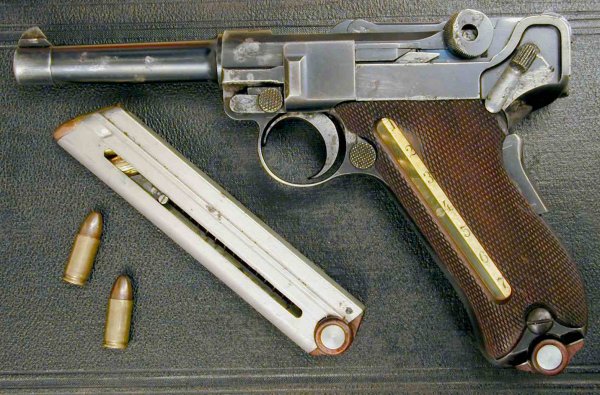
1902 Cartridge Counter Luger, serial number 22414
The Annual Report of the Chief of Ordnance for fiscal year 1904 (July 1, 1903-June 30, 1904) reported on the status of the test.
“Luger automatic pistol.-…the Board made provision for exchanging 50 of the 7.65 millimeter pistols for 50 of 9 millimeters of 3/7/8” inch barrel.
When received the pistols were sent to Fort Riley and, April 19, 1904 instructions were given by the Chief of Staff for tests of the pistols by the cavalry and field artillery boards.
The field artillery board reported that up to June 30, 1904, only a preliminary test of the arm had been made. The cavalry board has completed the tests and submitted its report.”
Reports of Test of 9 m/m Luger pistols
On July 4, 1904, the Cavalry Board met at Fort Riley, Kansas to consider the 9 m/m Luger pistol. The testing program included firing for familiarization, accuracy, rapidity, and performance during the mounted course of fire.
The following is extracted from the report of the board.
“The Board took up the subject of the Luger automatic Pistol, Cal 9 mm…
Examination of the pistol…as to design, safety features and suitability for mounted troops…was left to individual members of the Board, each of whom had been issued Luger pistols, Cal. 9mm., with sufficient ammunition to test it thoroughly by personal manipulation…
The Board, after discussing the data, then heard the reports of troop commanders, to whom 10 Luger pistols had been issued, with ammunition for trial. These were against the adoption of the Luger automatic pistol with its present imperfections.
The Board reached the following conclusions:
- The Luger automatic pistol, Cal. 9mm., is an accurate weapon at the distances at which it was tested.
- The jamming of cartridges, which occurred so frequently, completely nullifies the good qualities of the pistol and renders it practically useless.
Two of the pistols used by the Cavalry Board were recorded by serial number. These were pistols number 22414 and 22425 as illustrated in the pages from ref. 1 below.
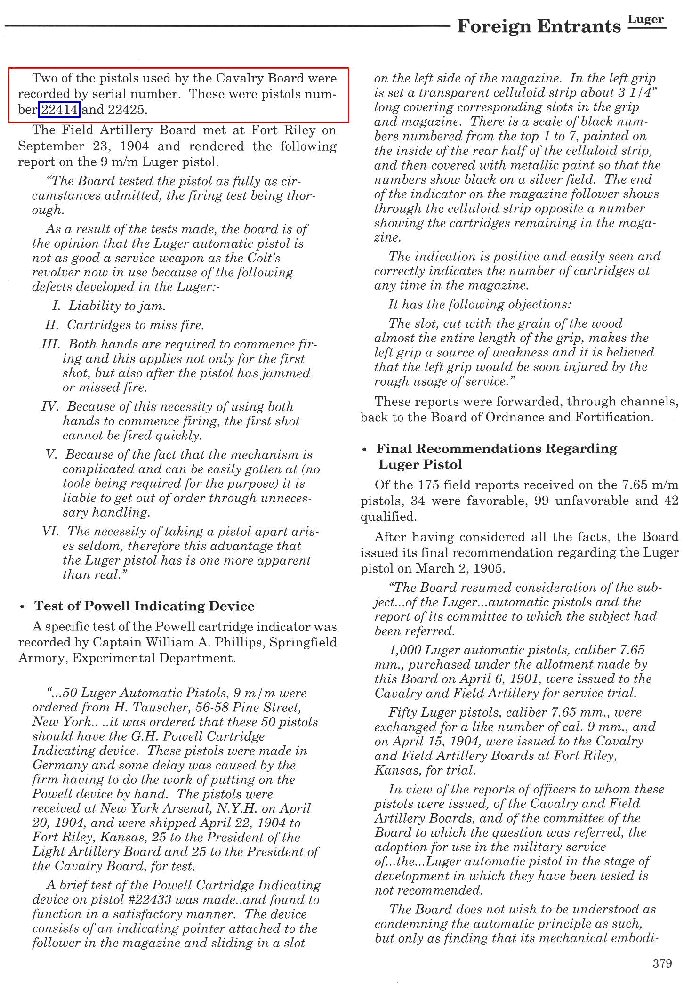
The fate or whereabouts of 1902 Luger Cartridge Counter Cal. 9mm serial number 22425 is unknown as of this writing but serial number 22414 survives and is currently part of the Land of Borchardt collection and is featured in this article. The provenance of 22414 dates back to the Annual Report of the Chief of Ordnance for fiscal year 1904 as tested by the U.S. Cavalry and shows evidence of hard testing. The test program for the 1902 9mm Cartridge Counter Luger, as directed by Springfield Armory personnel and carried out by the U.S. Calvary at Ft. Riley, Kansas included serial number 22414 and was conducted during the time frame of April 9, 1904 through June 30, 1904 a period of approximately 81 days or 2.7 months. The tests must have been harsh, extensive and severe as the pistol was, among other things dropped, probably from a horse as evidenced by the left side toggle knob. There is a minor chip out of the extractor claw underside and a minor ding in the rear link V notch sight and many, many rounds appear to have been expended through the pistol. Although cosmetically not of the most desirable collector grade the gun seems to have survived functionally and in many areas where the finish is intact exhibits excellent condition. The wooden grips survived intact, the barrel finish and the right side of the gun survive with 90% blue remaining. Serial number 22414 is a prime, serial number documented example of a rare and historically important 1902 Cartridge Counter Luger that has been subjected to an intense test program by the United States Cavalry in 1904.
The basic complaint of the Cavalry Board being the “jamming of the cartridges” is totally understandable when examining the 22414 Cartridge Counter magazine which has had the follower pointer/loaded indicator metal strip insert replaced, more than likely during the test program at Fort Riley. This is possible because it was at Fort Riley where the G.H. Powell indicator device was fitted to a Luger and submitted to DWM as a pilot model for the 50 9mm “Cartridge Counter” Lugers. There was no mention as to what Luger was fitted with the G.H. Powell indicator. It was not one of the prototypes being tested by the U.S. Army. 10030B is a 9mm prototype and 10060B is a late old model short frame 4-3/4” 30 Cal barrel prototype. A more likely candidate for the pilot Cartridge Counter model can be found in Luger: The Multi-National Pistol by C. Kenyon Jr. on p 50. Please note that the frame length is 129 mm, it is not a true short frame but a cut back long frame. In other words, a prototype and is therefore not one of the original 50 late old model production short frame Cartridge Counter Lugers delivered to the U.S. Army.
Also, a closer examination of the magazine follower shows that the button has been replaced or modified and that metal has been added to the follower underside. As a result of these modifications and the subsequent extensive use, the magazine seats poorly in the in the grip. It binds in the last few millimeters of insertion after engaging the frame magazine release button and also when the follower is a few millimeters from the top.
Typical Cartridge Counter (CC) features
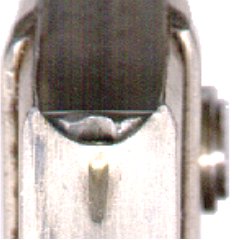 |
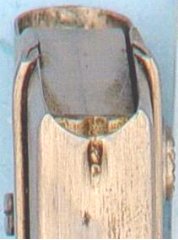 |
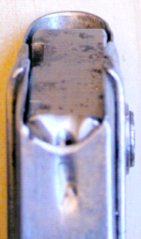 |
| CC magazine LOB collection |
1902 CC Luger, sn 22xxx Jan C. Still collection |
22414 CC magazine LOB collection |
Shown below is a drawing showing the dimensions of an original configuration 1902 Cartridge Counter magazine follower pointer inset which fits into the vertical milled slot in the follower left side. The follower pointer is as fabricated by the DWM tool room. Note the two piece original construction:
- Integral pointer/loaded indicator and metal strip.
- Integral domed follower button and shaft.

1902 Cartridge Counter magazine follower pointer inset
DWM factory configuration
The dimensions of the "modified" replacement 1902 Cartridge Counter magazine follower pointer/loaded indicator are noted where different from above drawing. The follower pointer was modified by the U.S. Army, repaired either by Springfield Armory or Rock Island Arsenal. Although the fact that a piece of metal was added to the underside of the follower indicates that the modification of this serial number 22414 Luger Cartridge Counter magazine was more than a repair. It may have been some form of experiment to improve the feeding an/or minimize the jamming proclivities of the Cartridge Counter 9mm Luger. Note the four piece construction of the modified 22414 magazine.
- Metal strip.
- Integral domed follower button with integral shaft with hole drilled at shaft end to accept pin 4.
- Separate pointer/loaded indicator with integral smaller diameter (2 mm) shaft.
- Pin (2 mm diameter x 5 mm) inserted into domed follower button shaft drilled hole and through hole in metal strip.
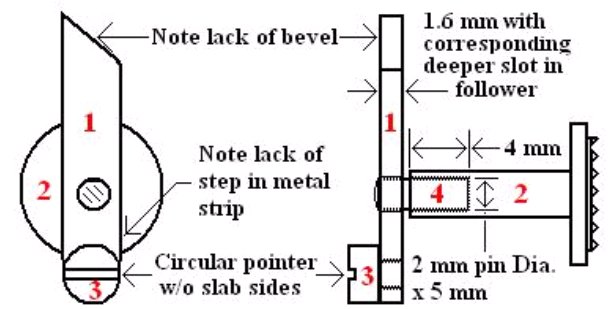
Configuration of 22414 “Cartridge Counter” magazine
Modified by the US Army.
The parts 1 and 2 metal strip and circular slotted pointer assembly were loose in the follower slot and were easily removed and photographed. The modification to the follower itself is harder to see as it cannot be removed from the magazine body without removing the right side domed follower button which is quite secure in the follower. Perhaps the added metal to the forward curved edge of the follower underside was meant to add more surface area and weight, therefore more stability to the follower as it cycles up the magazine body during firing.
1907 45 Cal Luger

The final association between the United States Army Ordnance Department, headed by William Crozier, Chief of Ordnance and Georg Luger was the submission, testing and subsequent rejection of the infamous 1907 45 caliber Luger in favor of the M1911 Colt. The results of the testing of the 45 Cal Luger and the competitors was the presented in an Appendix of the U.S. Army annual report for the Fiscal Year ending June 30, 1907. The report states the main reason for rejection of the 45 cal Luger as…. “Page 89, paragraph 24; The Luger automatic pistol, although it possesses manifest advantages in many particulars, is not recommended for service tests because its certainty of action, even with Luger ammunition, it is not considered satisfactory, because of the final seating of the cartridge is not by positive spring action, and because the powder stated by Mr. Luger to be necessary, for its satisfactory use is not now obtainable in this country.”
The most interesting document preceding the 1907 Army report is an extremely rare original, personal 2 page letter dated January, 28 1907 written to William Crozier, Chief of Ordnance and personally signed by the inventor Georg Luger. On the backside of the second page is typed “January 26, 1907 - New York” with a typed note highlighting the contents of the subject letter and an “Office of Chief of Ord. - WAR DEPARTMENT.” acknowledgement of receipt stamp, dated January 28, 1907. The stamp is accompanied with a hand written in ink file number 13092 and item number 422.
The contents of the letter are as follows:
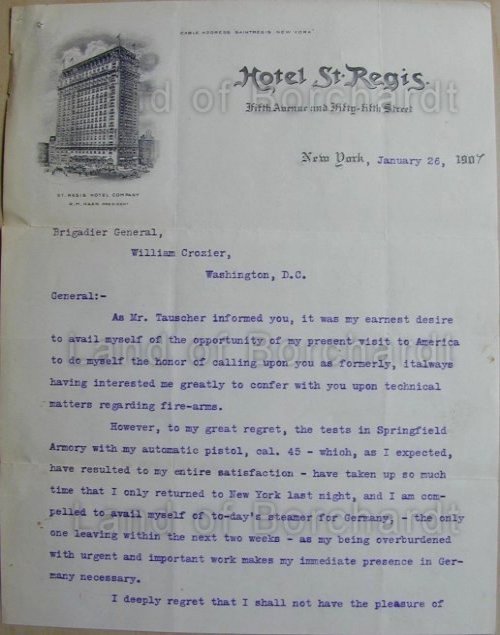
|
Close-up of hotel letterhead.
|
| Page 1 Page 2 |
Kaiser Wilhelm II Passenger Booklet, 1909
The Kaiser Wilhelm II is an example of one of four German steamers available in 1907. Kaiser Wilhelm der Grosse 1897, Deutschland 1900, Kronprinz Wilhelm 1903, Kronprinzessin Cecilie 1907 mentioned in the letter is shown below. The 1909 Kaiser Wilhelm II Passenger Booklet is a 42 page booklet for passengers sailing on the Kaiser Wilhelm II from Bremen to New York, June 15th 1909.

The 42 page booklet lists the Officers and first and second class passengers. Information on meals, barber and hair dresser services, bathrooms, smoking areas, etc., are given in both German and English. Timetables for other crossings and other ships are shown as well as information on round the world cruises. Included with the booklet is a post card of the ship in Port Bremerhaven.
 Home page
Home page